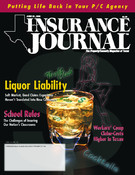A closer inspection of NAIC auto premium data reveals something much different than what the consumer media reported
When the National Association of Insurance Commissioners released its 2000 report, State Average Expenditures & Premiums for Personal Automotive Insurance in 1998, newspapers across the country reported the story, pointing out their particular state’s rankings.
The making of a snowball
In Texas, the Dallas Morning News was the first to report the story, pointing out how Texas maintained its ranking of 17th despite tort reforms in 1995, which were geared to help cut insurance costs. Other papers soon picked up the DMN’s story.
Replete with comments about insurers lining their respective pockets with the saved dollars that should have gone to consumers, the story made the ranking seem like the most important information contained in the report. More importantly, it referred to tort reform as though it was intended to reduce auto insurance premiums.
“Insurers are pocketing extra profits while Texas drivers continue to pay the 17th-highest premiums in the country,” consumer advocate D.J. Powers was quoted as saying in the article.
When questioned about his comments and the contents of the NAIC report, Powers admitted to the Insurance Journal he had not even seen the report when he made those comments.
And when questioned about other contents in the report, such as the fact that the average increase in auto premiums rose 8.23 percent nationwide between 1995 and 1998 compared to Texas’ 2.31 percent (fifth best in the nation), he maintained that the ranking was far more important than those figures.
“The bottom line is, if tort reform had all these benefits for consumers, Texas wouldn’t be ranked 17th,” he said.
The article caused enough concern with the Texas Department of Insurance to warrant a letter to the editor pointing out the issues overlooked or minimized in the story, including the fact that average auto liability premiums in Texas actually decreased 5.53 percent in Texas while the national average increased 1.42 percent. Also, Texas had the fourth best performance in average auto liability premiums.
On top of that, the reforms Powers refers to, which occurred in Texas in 1995, were geared primarily to reduce liability insurance coverages for doctors and other businesses by reducing lawsuits, according to Jerry Johns, president of Southwestern Insurance Information Service. It was mere happenstance that personal auto premiums benefited from the changes.
“Tort reform has had some impact on auto insurance, though, truthfully, it was never intended to impact auto insurance,” Johns said. “But I think if we had to single out one thing [that has affected auto insurance premiums in Texas]…that would be tort reform.”
According to Jon Opelt, Houston director of Citizens Against Lawsuit Abuse, lawsuits for injuries or damages involving motor vehicles in Texas have decreased since tort reforms were introduced by 25 percent, down from 22,334 in 1995 to 16,768 in 1999.
What the numbers DO say
So how does Texas really compare to other states? Well, the state with the most expensive personal auto premiums, New Jersey, saw premium expenditures increase 18.11 percent between 1994 and 1998, with average coverage costs rising from $963.73 to $1,138.28 per insured vehicle. The state with the lowest premium expenditures, North Dakota, saw an increase of 22.84 percent from $367.99 in 1994 to $452.03 in 1998.
Comparably, Texas saw premiums increase from $714.17 to $730.66, or 2.31 percent, during the same period.
Also in the middle of the pack and right next door to Texas at No. 18 was West Virginia, which saw a 17.05 percent increase in premium expenditures from 1994 to 1998. Only four states saw decreases in premium expenditures, with Hawaii leading the pack at -17.06 percent. Massachusetts experienced a 13.04 percent decrease, followed by California at -9.06 percent and Rhode Island at -1.05 percent.
Nationwide, premium expenditures in 1998 averaged $704.32 per insured vehicle according to the report, up from $650.73 in 1994.
Look to the sub-text
So which figures give a truer view of how Texas auto premium expenditures compare to other states, rank or comparable changes in premium? The report itself answers that question.
“Insurance prices are determined primarily by the cost of claims filed by the insured,” the report explains. “Many of these cost factors can impact prices not only between states, but between communities and neighborhoods as well, making price comparison between states extremely complex.”
These factors include general economic conditions, average annual income per capita, number of cars per square mile and the relative degree of traffic congestion. In fact, the study found a direct correlation between high average premium expenditures and high average income, large metropolitan populations and number of miles driven.
While Texas was not among the top 10 states in those areas, Texas has many problems a tort reform bill can’t solve: hail, huge population increases, traffic congestion and lack of extensive public transportation, among others.
Meanwhile, in early May, Texas insurance companies requested a 10.6 percent increase in the state’s average benchmark rate, while consumer advocates sought a decrease of 4.8 percent. Two administrative law judges have suggested an increase of 1.9 percent. Insurance Commissioner Jose Montemayor is expected to rule on the new rates soon after July 1.
To comment on the article, e-mail cparten@insurancejournal.com.
Was this article valuable?
Here are more articles you may enjoy.


 North Carolina Adjuster and Son Charged With Embezzlement in Roof Jobs
North Carolina Adjuster and Son Charged With Embezzlement in Roof Jobs  Marsh McLennan Agency to Buy Fisher Brown Bottrell for About $316M
Marsh McLennan Agency to Buy Fisher Brown Bottrell for About $316M  Trump’s Bond Insurer Tells Judge Shortfall Is ‘Inconceivable’
Trump’s Bond Insurer Tells Judge Shortfall Is ‘Inconceivable’  Why New York’s Attorney General Objects to Trump’s Bond Insurer
Why New York’s Attorney General Objects to Trump’s Bond Insurer 


